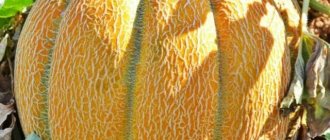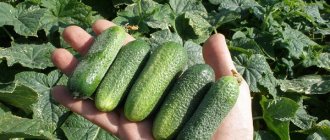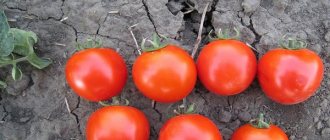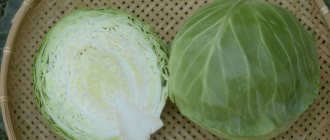Among the wide variety of varieties, Rinda cabbage, the description of which is discussed in the article, belongs to a special category. It is most often chosen by amateur gardeners and commercial enterprises for its excellent taste, high yield and unpretentiousness in the growing process. The full name of the variety is Rinda F1. It is a hybrid bred abroad. Manufacturer: Dutch agricultural company Monsanto. Rinda F1 cabbage was included in the state register of the Russian Federation in 1993. The product is popular not only in Russia, but throughout the world.
Short description
Being a mid-season variety of white cabbage, Rinda F1 has unique properties. It is perfect for fresh consumption, as well as for preparing for the winter and storing for several months.
Typically, mature cabbage weighs about 3-6 kg, but there is evidence that experienced gardeners were able to grow specimens weighing up to 10 kg. The heads of cabbage are spherical in shape and very dense. They have a beautiful internal structure. When cut, the color is yellow-white. Able to survive on the root for a long time. The outer stalk is short. The leaves are thin and at the same time elastic, with thin veins. They have a light green color. A distinctive feature is its delicate and juicy taste. The hybrid has a compact rosette and average spreading. Leaves are semi-raised. They are an excellent material for preparing cabbage rolls and other dishes.
Breeding history
Rinda F1 is a hybrid of white cabbage (Brassica oleracea var. capitata) of medium maturity.
It was bred by Dutch breeders of the agricultural company Seminis Vegetable> In 2005, Seminis became part of a larger structure - the Moanto Company. This company, headquartered in the US state of Missouri, became famous as the manufacturer of the world-famous herbicide Roundup.
In 1993, Rinda was included in the State Register of the Russian Federation for cultivation in two regions - Central and Vyatka. When grown in other areas, it may not show all its positive qualities.
Advantages of a hybrid
The variety is characterized by high productivity. From 1 sq. m you can collect up to 10 kg of product. The ripening of heads of cabbage is friendly. This simplifies the process of collecting them and makes it possible to prepare the product in a short time. The vegetable is unpretentious to climatic conditions and soil conditions. Calmly tolerates temperature changes. Resistant to various diseases and pests, as well as browning of the leaf edges. Can be stored for up to 4 months. If the temperature and humidity conditions are observed, it will last until April. The taste of this variety is excellent. The product tolerates transportation well. Even when fully ripe, the heads of cabbage do not crack.
Pest and disease control
The fight against the following common cabbage diseases, which are also dangerous for the Rinda variety, will require special measures:
- Kila. It loves acidic soils, so adding lime to the soil in the fall, as well as watering the beds with a solution of Bordeaux mixture before planting seedlings, is a standard set of protective measures.
- Cabbage mosaic. You should carefully examine the plantings, and if you find suspicious plants with traces of disease on the leaves, quickly destroy them.
- Vascular bacteriosis. The disease can be treated with Planriz, which is used to spray the garden bed twice with an interval of 20 days.
Pest control can be carried out chemically (spraying with Groza, Kemifos, Iskra-M), as well as by sprinkling the beds with a mixture of ash and tobacco, so unloved by caterpillars, slugs and butterflies.
Growing and care
The Rinda variety is grown in various climatic conditions. Sowing of seeds occurs in mid to late March. When 40 days have passed after the first shoots, you can transfer the plant to open ground. Planting is scheduled for the end of April. It will take approximately 90 days from the moment the seedlings are transferred to open ground until they are fully ripened. For 10 sq. m it is recommended to plant no more than 40 pcs. plants. Excessive thickening will lead to a decrease in yield. The planting pattern should be 35x50 cm.
Late-ripening hybrid Kolobok F1
Connoisseurs of the qualities of white cabbage Rinda F1 may also like the magnificent late-ripening hybrid Kolobok F1. Read more about the hybrid...
The plant will develop well only if it is properly cared for. Watering, hilling and loosening the soil are necessary components. And to protect cabbage from pests, you can use wood ash and a solution of acetic acid. In order for the heads of cabbage to be juicy and strong, it is necessary to fertilize several times. Basically, Rinda F1 cabbage needs nitrogen fertilizers.
Growing Rinda cabbage
For planting the Rinda variety, choose areas where there is no shade from trees and fences, since if there is a lack of sun, the heads of cabbage may not set at all. In such cases, a cap of leaves grows on the stem and the growing season ends.
Among the crops that are excellent precursors for Rinda cabbage are zucchini, carrots, cucumbers, legumes, garlic, onions, and potatoes. Sowing after cruciferous vegetables (turnips, radishes, etc.) shows poor results, since cabbage shares common diseases and pests with them. The maximum permissible period for growing Rinda in one place is 2 years, but then it will be possible to return it again no earlier than after 4 years. The optimal soil pH for Rinda is 6.5-7.5.
Planting seedlings
Rind cabbage seeds are commercially available in two forms: regular and in shells. The second option is the most preferable, since this seed has already been thoroughly sorted. Selected seeds are enclosed in a shell of those mineral substances that seedlings need in the first days of life.
The soil is prepared independently in the proportion: humus and soil with a neutral reaction 1:1, and for each kilogram of the mixture an additional tablespoon of wood ash is added. On sale you can also find ready-made soil marked “for cabbage”.
Containers (cups) are suitable with a height of 15 cm, you can use boxes. In those regions for which the Rinda cabbage variety is zoned, sowing is carried out in the first ten days of April. Seeds are planted to a depth of 1.5-2 cm. The optimal temperature for germination is + 20 °C. Shoots appear in 3-5 days. Adult seedlings are considered at the age of 35 days after emergence.
To prevent the seedlings of the Rinda variety from stretching, the containers are transferred to a bright but cool window (optimal temperature + 10 ° C). Basic care consists of regular watering. Since the soil must be moist all the time, there is a high risk of blackleg and mold occurring due to insufficient ventilation. Therefore, the soil is powdered with wood ash and watered with Glyocladin solution.
Special soil mixtures for seedlings already contain fertilizers, so there is no need to feed the seedlings. Humus in self-prepared soil is also quite enough. If, under optimal conditions, the seedlings behave passively and are in no hurry to grow, you can use any recommended complex mineral fertilizer for a one-time feeding at the age of 10 days.
Transplanting cabbage into open ground
If the soil at the planting site is acidic, it must be neutralized. To do this, in the fall, fluff lime, dolomite flour or crushed chalk are added to the beds in the amount of 1 cup per square meter. Fertilizers are also applied in the fall (per 1 m2):
- 30 g of superphosphate (or 40 g of potassium sulfate).
- 15 kg of humus.
- 1 cup wood ash.
In the spring, before planting, fertilizers are also applied:
- 45 g urea.
- 1.5 buckets of humus.
The indicated amounts are required for poor soils, and for fertile soils the dosage is reduced by 2 times. The soil is dug up in the fall, but not harrowed, and repeated digging and harrowing is carried out in the spring.
Seedlings of the Rinda variety are planted in open ground at the end of May. It can withstand short-term frosts down to -5 °C. The optimal planting scheme for sowing seeds and adult seedlings: 70x45 cm. Since tender sprouts are a delicacy for many insects and slugs, they use agrofibre shelters at night to protect them from them, as well as sprinkling the beds with wood ash.
Aftercare for cabbage
In the first 2 weeks after planting the seedlings in the beds, watering is carried out once every 3 days. 1.5 liters of water are poured under each plant of the Rinda variety. Then you can carry out general watering at the rate of 10 liters per 1 m2. When the heads are setting and ripening, the water consumption rate is up to 20 liters per 1 m2, and watering should be done every other day.
If the weather is hot and dry, the application rate may be increased. You need to stop watering the Rinda variety 2 weeks before harvest. This usually happens 70 days after planting the seedlings in the ground (late July). Don't rely on precipitation. Cabbage roots are located mainly at a depth of 30-40 cm. If the soil at such a depth is dry, then the plant will suffer from a lack of moisture.
In total, 3 feedings are carried out for the Rinda variety:
- 20 days after planting the seedlings in the beds. Add 0.5 liters to each bush of any of the solutions: mullein (0.5 kg per 10 liters of water), urea (30 g per 10 liters of water), ammonium nitrate (20 g per 10 liters of water).
- After 14 days, mullein or 1 liter of nitroammophos solution (2 tablespoons per 10 liters of water) is added to each plant.
- After another 2 weeks, water again with mullein solution with the addition of 30 g of superphosphate, or apply a complex mineral fertilizer for cabbage (Kemir, Kristalon, etc.).
It is very important to ensure good soil aeration, for which purpose the drying soil is loosened between waterings. Also, you should not allow the crops to become clogged with weeds, which quickly deplete the soil.
Brief characteristics of the hybrid (table)
| Variety or hybrid | hybrid |
| Ripening time | mid-season |
| Kochan | spherical, dense |
| Kocheryzhka | short |
| Disease resistance | variety is resistant to major diseases |
| Fruit weight, g | 3000-4000 |
| Growing areas | the entire territory of the Russian Federation, as well as Ukraine, Moldova, Kazakhstan and other countries |
| Disembarkation scheme | 35cm x 50cm |
| From germination to ripeness | 85-90 days |
| Seed placement depth | 1.5-2 cm |
| Seedling age | 30-40 days |
| Soil temperature for planting seeds/seedlings | +4/+12 |
| Advantages | high transportability, does not crack, uniform ripening, forks of the same size, excellent commercial qualities, excellent taste, thin sheet |
| Flaws | moisture-loving, light-loving |
Did the article help you?
Harvesting and storage
The readiness of heads of cabbage for cutting is checked in August or September. If most of the heads in the bed are firm, they are ready to harvest. Rinda cabbage has good resistance to cracking, but it’s still not worth keeping the crop standing. This will negatively affect the shelf life of the product in autumn and winter.
Mass harvesting of heads of cabbage begins in warm and dry weather. They do not remove them after rain - a lot of moisture accumulates in the leaves, which leads to rot of the heads during storage. Cabbage heads are cut with a sharp knife, leaving a stalk 3-5 cm long and a row of outer leaves. This will keep the heads fresh longer and protect them from spoilage.
Before storing in storage, the heads are dried a little under a canopy, and then transferred to a permanent place. The cabbage harvest is stored in the most usual way - in the basement, cellar, shed, or on the balcony. The best conditions are a temperature from 0 to +1 °C, a humidity of 95% and good ventilation of the room where the vegetables are stored.
We recommend reading
Which type of cabbage to choose for pickling, pickling and storing for the winter
Schemes and rules for applying fertilizers to cabbage
Features and methods of storing white cabbage
Rules for planting cabbage in open ground
Measures to increase yield
Loosening (at least once a week) has a beneficial effect on the harvest. A crust should not be allowed to form on the surface of the soil after watering; this makes it difficult for oxygen to reach the roots.
If necessary (if the plants are frail, pale, or stretched out), you can fertilize them with a solution of mullein, urea or ammonium nitrate.
It is recommended to hill up plants twice a season . The first time - 2 weeks after disembarkation, the second - two months later.
Advantages and disadvantages of the variety
Cabbage Gift
The characteristics of a variety include its positive and negative qualities. The advantages of Rinda cabbage are:
- excellent sweet taste and juicy pulp;
- high yield rates;
- long-lasting presentation, good keeping quality and simultaneous ripening of heads of the same size;
- unpretentiousness to growing conditions and soil composition;
- easily adapts to temperature differences;
- high resistance against typical diseases.
The disadvantages of this cabbage hybrid are as follows:
- there is no resistance to long periods without water, as well as to stagnation of moisture;
- increased need for insolation; if there is a lack of it, the heads of cabbage may not set;
- may be affected by slugs and fleas;
- Due to its popularity, there is a risk of purchasing fake seed material.
The main feature of mid-season Rinda cabbage is its unpretentiousness in care, as well as good yield, which makes it suitable for cultivation in various climatic zones of Russia. This guarantees Rinda well-deserved popularity among gardeners, despite the huge selection of white cabbage on the market.
0 0 votes
Article rating











